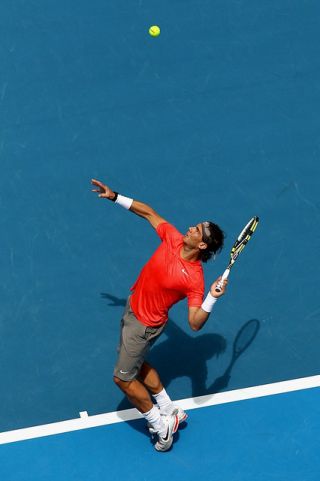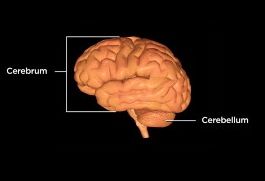Neuroscience
Ready, Set, Go! How Does the Brain Prepare for Movements?
The brain has two separate systems for anticipated and unanticipated movements.
Posted January 24, 2014
Neuroscientists and engineers at Stanford University are trying to design better brain-controlled prosthetic limbs. In a groundbreaking new 

Neuroscientists and engineers at Stanford University are trying to design better brain-controlled prosthetic limbs. In a groundbreaking new
When you anticipate a physical action—such as reaching for a cup of coffee or preparing to serve a tennis ball—the neurons that control the task adopt a state of readiness, like sprinters bent into a crouch, or a tiger waiting to pounce. Other times, however, our neurons must simply react, like when you see a cup of coffee about to spill onto your keyboard, or when you prepare to volley a speeding tennis ball.
The researchers at Stanford were curious to figure out how the neurons in the brain control planned versus unplanned arm movements. These applications are useful for everyday life, sports, and for anyone who relies on a prosthetic. Krishna Shenoy, a Stanford professor of electrical engineering, neurobiology and bioengineering, is primarily motivated to improve brain-controlled prosthetic devices.
The research paper, titled “Neural Dynamics of Reaching Following Incorrect or Absent Motor Preparation” was published January 22, 2014 in the journal Neuron. Shenoy and first author Katherine Cora Ames, a doctoral student in the Neurosciences Graduate Program, present a mathematical analysis of the brain activity of monkeys as they make anticipated and unanticipated reaching motions.
Monitoring Anticipated and Unanticipated Reaching Motion
The experimental data came from recording the electrical activity of neurons in the brain that control motor and premotor functions. The idea was to observe and understand the activity levels of these neurons during experiments in which the monkeys made planned or reactive arm movements.
What the researchers found is that when the monkeys knew what arm movement they were supposed to make and were simply waiting for the cue to act, electrical readings showed that the neurons went into what scientists call the “prepare-and-hold” state—the brain's equivalent of ready, set, waiting for the cue to go.
When serving a tennis ball for example, players often learn to create a ‘prepare-and-hold’ state just prior to the anticpiated motion of serving the ball. Most players have a pre-serve routine—like bouncing the ball a few times or bringing the tennis ball to the strings, pausing—and then automatically letting the anticipated procedural muscle memory held in the cerebellum activate to serve the ball. The pause before serving is the cue to prepare your muscle memory to go on autopilot.
In an unexpected twist the researchers at Stanford found that when the monkeys had to make unplanned or unexpected movements, that neurons did not go through the expected prepare-and-hold state. "This was a surprise," Ames said.
Before the experiment, the researchers had believed that a prepare-and-hold state automatically had to precede any arm movement. In short, they thought the neurons had to go into a "ready, set"—or crouching tiger mode—before acting on the "go" command.

Tennis player Arthur Ashe proposed that over-thinking a movement in tennis would create “paralysis by analysis.” In my split-brain model between the cerebrum and cerebellum I put the cerebral pre-planned motions in the executive suite of the cerebrum. The automatic ‘non-thinking’ reflexive motor skills are held in the muscle memory of the cerebellum. It makes sense that lightning fast reflexive movements bypass the 'ready, set' phase.
I have written numerous Psychology Today blog posts on the importance of practice, practice, practice for strengthening the automatic muscle memory system of the cerebellum needed for unpredictable, and unexpected movements. Being a good athlete is all about optimizing both anticipated and unanticipated motor systems.
"Ready, Set" Are Not Always Necessary for Muscles to "Go!"
The researches used three different experiments to train monkeys in variety of circumstances that required them to touch a target that appeared on a display screen. During each motion, the researchers measured the electrical activity of the neurons in control of arm movements.
In one set of experiments, the monkeys were shown the target but were trained not to touch it until they got the "go" signal. This is called a delayed reach experiment. It served as the planned action. In a second set of experiments the monkeys were trained to touch the target as soon as it appeared. This served as the unplanned action. In a third variant, the position of the target was changed. It briefly appeared in one location on the screen. The target then reappeared in a different location. This required the monkeys to revise their movement plan.
It is worth noting that the ability to track a target and coordinate head and eye movements to keep your ‘eye on the ball’ or any target is called “Vestibulo-Ocular Reflex” (VOR) and is also a function of the cerebellum. Ames said that, in all three instances, the first information to reach the neurons was awareness of the target. "Perception always occurred first," Ames said.

Interestingly, about 50 milliseconds after awareness of the target some differences appeared in the data. When the monkeys had to wait for the go command, the brain recordings showed that the neurons went into a discernable prepare-and-hold state. But in the other two cases, the neurons did not enter the prepare-and-hold state.
My educated guess would be that during unanticipated arm movements the monkeys were bypassing the ‘cerebral’ aspects of planned movement and relying solely on cerebellar reflexes to hit the target. This is exactly what athletes do in sport. As Wayne Gretzky said, "A good hockey player plays where the puck is. A great hockey player plays where the puck is going to be."
Roughly 50 milliseconds after the electrical readings showed evidence of perception, a change in neuronal activity signaled the command to touch the target; it came with no apparent further preparation between perception and action. "Ready, set" was unnecessary. In these instances, the neurons just said, "Go!"
The cerebellum is only 10% of brain volume but holds over 50% of your brain’s neurons. The cerebellum is the seat of implicit learning—which are actions that you do without having to consciously think about the movements. Although this study does not mention the cerebellum, it would make sense that the lightning fast responses the researchers found in unanticipated movements that bypass the ‘ready, set’ phase could be linked to the implicit memory system held in the cerebellum.
Conclusions: Understanding Muscle Movement Processes Has Broad Applications
"This study changes our view of how movement is controlled," Ames said. "First you get the information about where to move. Then comes the decision to move. There is no specific prepare-and-hold stage unless you are waiting for the signal to move."
These nuanced understandings are especially intriguing to Shenoy. His lab develops and improves electronic systems that can convert neural activity into electronic signals in order to control a prosthetic arm or move the cursor on a computer screen.
One example of such efforts is the BrainGate clinical trial at Stanford, which is testing the safety of brain-controlled, computer cursor systems—called "think-and-click" communication for people who can't move. "In addition to advancing basic brain science, these new findings will lead to better brain-controlled prosthetic arms and communication systems for people with paralysis," Shenoy concluded.
If you'd like to read more on this topic, check out my Psychology Todayblogs:
- "No. 1 Reason Practice Makes Perfect"
- "The Mysterious Neuroscience of Learning Automatic Skills"
- "The Neuroscience of Imagination"
- "Why Does Overthinking Cause Athletes to Choke?"
- "Gut Feelings Can Predict the Odds of Marital Bliss"
- "Can Mindfulness Backfire?"
- "Our Unconscious Mind Catches Grammatical Errors"
- "Tongue Twisters Reveal Quirky Brain Functions"
- "Checkmate! Winning Life Strategies of a Chess Grandmaster"
Follow me on Twitter @ckbergland for updates on The Athlete’s Way blog posts.




